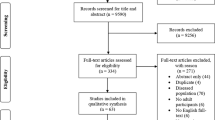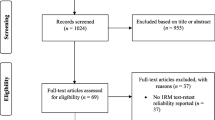Abstract
Background
Despite differences between the studies regarding methods for estimating low muscle mass, the European Working Group on Sarcopenia in Older People (EWGSOP) recommends use of two standard deviations (SDs) below the reference sex-specific means of healthy young adults.
Aims
The aim of this study was to determine the cutoff points of skeletal muscle mass index (SMI) and handgrip strength (HS) in Turkish population and to compare the power of different cutoff points to predict comprehensive geriatric assessment (CGA) parameters.
Methods
Two hundred and eight young healthy volunteers (104 women, 104 men) were included in the study to define SMI, HS cutoff values. 1150 older adults (784 women, 366 men) underwent CGA, including physical performance, activities of daily living (ADL), HS and frailty. Body composition was obtained from every participant by bioimpedance analysis (BIA). CGA parameters of sarcopenic patients according to EWGSOP and new Turkish cutoff points were compared.
Results
SMI cutoff points were defined 5.70 kg/m2 for women, 8.33 kg/m2 for men. HS thresholds were calculated as 14 kg for women, 28 kg for men using measurements of healthy young adult reference. Considering the new threshold values, the prevalence of sarcopenia was 10% (7% women, 17% men). When new sarcopenia criteria were applied and covariates were adjusted, sarcopenia was found to be more closely related to ADL impairment, balance, frailty in men, and balance, slow walking speed, ADL impairment, frailty in women (p < 0.05).
Discussion
Muscle mass and strength may vary between populations because of ethnicity and other related discrepancies. The evaluation of sarcopenia according to the present guidelines may cause overdiagnosis in some populations.
Conclusion
Cutoff points specific to populations should be determined.
Similar content being viewed by others
References
Cesari M, Landi F, Vellas B et al (2014) Sarcopenia and physical frailty: two sides of the same coin. Front Aging Neurosci 6:192. https://doi.org/10.3389/fnagi.2014.00192
Cruz-Jentoft AJ, Baeyens JP, Bauer JM et al (2010) Sarcopenia: European consensus on definition and diagnosis: report of the European Working Group on Sarcopenia in older people. Age Ageing 39:412–423. https://doi.org/10.1093/ageing/afq034
Cruz-Jentoft AJ, Bahat G, Bauer J et al (2018) Sarcopenia: revised European consensus on definition and diagnosis. Age Ageing. https://doi.org/10.1093/ageing/afy169
Chen LK, Liu LK, Woo J et al (2014) Sarcopenia in Asia: consensus report of the Asian Working Group for Sarcopenia. J Am Med Dir Assoc 15:95–101. https://doi.org/10.1016/j.jamda.2013.11.025
Chen LK, Lee WJ, Peng LN et al (2016) Recent advances in Sarcopenia research in Asia: 2016 update from the Asian Working Group for Sarcopenia. J Am Med Dir Assoc 17:767.e761–767.e767. https://doi.org/10.1016/j.jamda.2016.05.016
Jensen B, Moritoyo T, Kaufer-Horwitz M et al (2018) Ethnic differences in fat and muscle mass and their implication for interpretation of bioelectrical impedance vector analysis. Appl Physiol Nutr Metab. https://doi.org/10.1139/apnm-2018-0276
Dhillon RJ, Hasni S (2017) Pathogenesis and management of Sarcopenia. Clin Geriatr Med 33:17–26. https://doi.org/10.1016/j.cger.2016.08.002
Marzetti E, Calvani R, Tosato M et al (2017) Sarcopenia: an overview. Aging Clin Exp Res 29:11–17. https://doi.org/10.1007/s40520-016-0704-5
Alencar MA, Dias JM, Figueiredo LC et al (2012) Handgrip strength in elderly with dementia: study of reliability. Revista brasileira de fisioterapia 16:510–514
Unutmaz GD, Soysal P, Tuven B et al (2018) Costs of medication in older patients: before and after comprehensive geriatric assessment. Clin Interv Aging 13:607–613. https://doi.org/10.2147/cia.s159966
Durmaz B, Soysal P, Ellidokuz H et al (2017) Validity and reliability of geriatric depression scale-15 (short form) in Turkish older adults. North Clin Istanb. https://doi.org/10.14744/nci.12017.85047
Fried LP, Tangen CM, Walston J et al (2001) Frailty in older adults: evidence for a phenotype. J Gerontol Ser A Biol Sci Med Sci 56:M146–M156
Cesari M, Leeuwenburgh C, Lauretani F et al (2006) Frailty syndrome and skeletal muscle: results from the Invecchiare in Chianti study. Am J Clin Nutr 83:1142–1148
Roberts HC, Denison HJ, Martin HJ et al (2011) A review of the measurement of grip strength in clinical and epidemiological studies: towards a standardised approach. Age Ageing 40:423–429. https://doi.org/10.1093/ageing/afr051
Soysal P, Ates Bulut E, Yavuz I et al (2019) Decreased basal metabolic rate can be an objective marker for sarcopenia and frailty in older males. J Am Med Dir Assoc 20:58–63. https://doi.org/10.1016/j.jamda.2018.07.001
Janssen I, Heymsfield SB, Baumgartner RN et al (2000) Estimation of skeletal muscle mass by bioelectrical impedance analysis. J Appl Physiol 89:465–471
Baumgartner RN, Koehler KM, Gallagher D et al (1998) Epidemiology of sarcopenia among the elderly in New Mexico. Am J Epidemiol 147:755–763
Gallagher D, Visser M, De Meersman RE et al (1997) Appendicular skeletal muscle mass: effects of age, gender, and ethnicity. J Appl Physiol 83:229–239. https://doi.org/10.1152/jappl.1997.83.1.229
Chien MY, Huang TY, Wu YT (2008) Prevalence of sarcopenia estimated using a bioelectrical impedance analysis prediction equation in community-dwelling elderly people in Taiwan. J Am Geriatr Soc 56:1710–1715. https://doi.org/10.1111/j.1532-5415.2008.01854.x
Tichet J, Vol S, Goxe D et al (2008) Prevalence of sarcopenia in the French senior population. J Nutr Health Aging 12:202–206
Masanes F, Culla A, Navarro-Gonzalez M et al (2012) Prevalence of sarcopenia in healthy community-dwelling elderly in an urban area of Barcelona (Spain). J Nutr Health Aging 16:184–187
Villada-Gomez JS, Gonzalez-Correa CH, Marulanda-Mejia F (2018) Provisional cut-off points for the diagnosis of sarcopenia in elderly people from Caldas (Colombia). Biomedica 38:521–526. https://doi.org/10.7705/biomedica.v38i4.4302
Peterson SJ, Braunschweig CA (2016) Prevalence of sarcopenia and associated outcomes in the clinical setting. Nutr Clin Pract 31:40–48. https://doi.org/10.1177/0884533615622537
Ates Bulut E, Soysal P, Aydin AE et al (2017) Vitamin B12 deficiency might be related to sarcopenia in older adults. Exp Gerontol 95:136–140. https://doi.org/10.1016/j.exger.2017.05.017
Bahat G, Tufan A, Tufan F et al (2016) Cut-off points to identify sarcopenia according to European Working Group on Sarcopenia in Older People (EWGSOP) definition. Clin Nutr 35:1557–1563. https://doi.org/10.1016/j.clnu.2016.02.002
Soysal P, Isik AT (2016) Comment on “Cut-off points to identify sarcopenia according to European Working Group on Sarcopenia in Older People (EWGSOP) definition”. Clin Nutr 35:1586. https://doi.org/10.1016/j.clnu.2016.09.007
Fielding RA, Vellas B, Evans WJ et al (2011) Sarcopenia: an undiagnosed condition in older adults. Current consensus definition: prevalence, etiology, and consequences. International working group on sarcopenia. J Am Med Dir Assoc 12:249–256. https://doi.org/10.1016/j.jamda.2011.01.003
Makizako H, Shimada H, Doi T et al (2017) Age-dependent changes in physical performance and body composition in community-dwelling Japanese older adults. J Cachexia Sarcopenia Muscle 8:607–614
He X, Li Z, Tang X et al (2018) Age- and sex-related differences in body composition in healthy subjects aged 18 to 82 years. Medicine 97:e11152. https://doi.org/10.1097/md.0000000000011152
Goodpaster BH, Park SW, Harris TB et al (2006) The loss of skeletal muscle strength, mass, and quality in older adults: the health, aging and body composition study. J Gerontol Ser A Biol Sci Med Sci 61:1059–1064
Menant JC, Weber F, Lo J et al (2017) Strength measures are better than muscle mass measures in predicting health-related outcomes in older people: time to abandon the term sarcopenia? Osteoporos Int 28:59–70. https://doi.org/10.1007/s00198-016-3691-7
Dent E, Morley JE, Cruz-Jentoft AJ et al (2018) International Clinical Practice Guidelines for Sarcopenia (ICFSR): screening, diagnosis and management. J Nutr Health Aging 22:1148–1161. https://doi.org/10.1007/s12603-018-1139-9
Leong DP, Teo KK, Rangarajan S et al (2016) Reference ranges of handgrip strength from 125,462 healthy adults in 21 countries: a prospective urban rural epidemiologic (PURE) study. J Cachexia Sarcopenia Muscle 7:535–546. https://doi.org/10.1002/jcsm.12112
Roubenoff R, Baumgartner RN, Harris TB et al (1997) Application of bioelectrical impedance analysis to elderly populations. J Gerontol Ser A Biol Sci Med Sci 52:M129–M136
Acknowledgements
Authors thank healthy participants for contributing to the study.
Funding
None.
Author information
Authors and Affiliations
Contributions
EAB performed manuscript writing and data collection; PS reviewed the manuscript, carried out conceptualism; OD, SEK and AEA contributed data collection; IY made the statistical analysis, ATI designed the study and supported manuscript writing.
Corresponding author
Ethics declarations
Conflict of interest
The authors declare that they have no conflict of interest.
Ethical approval
Ethics committee approval was received for this study from the Ethics Committee of the Dokuz Eylul University. The investigation was conformed to the Declaration of Helsinki.
Informed consent
Informed consent was obtained from all individual participants included in the study.
Additional information
Publisher's Note
Springer Nature remains neutral with regard to jurisdictional claims in published maps and institutional affiliations.
Rights and permissions
About this article
Cite this article
Ates Bulut, E., Soysal, P., Dokuzlar, O. et al. Validation of population-based cutoffs for low muscle mass and strength in a population of Turkish elderly adults. Aging Clin Exp Res 32, 1749–1755 (2020). https://doi.org/10.1007/s40520-019-01448-4
Received:
Accepted:
Published:
Issue Date:
DOI: https://doi.org/10.1007/s40520-019-01448-4




